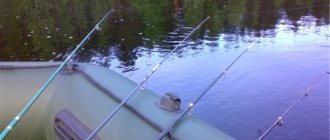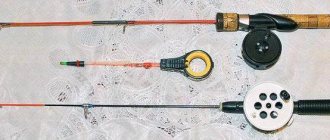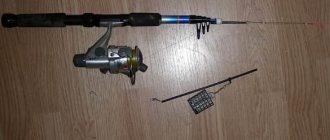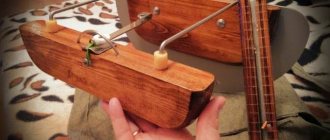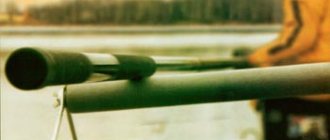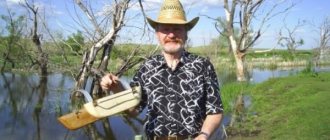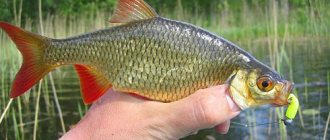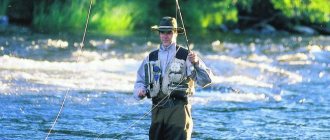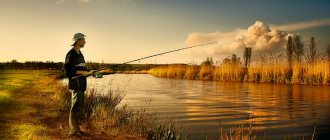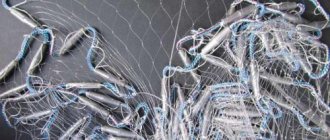Spider fishing is not clearly perceived by fishermen and, given some parameters of the device, is considered a purely poaching method of catching fish, which has nothing in common with sport fishing. But in some cases, fishing tackle is permitted for use under legitimate conditions and is an excellent help for anglers hunting for predatory fish and constantly in need of live bait. Such a tool can be purchased without any problems in a network of fishing stores and, equipped with a lightweight pole and a ten-meter piece of strong, small-diameter rope, can be used to ensure fishing with fresh live bait.
The article presented to the reader will help to understand the types of spiders for fishing, understand its operating principle and how to make it yourself. The fisherman will be given recommendations for choosing promising fishing spots with this tool, and the nuances of the geometric characteristics and devices permitted for its legal use will be discussed.
What is a spider fishing tackle?
A fishing spider, or also a product called a lift in the fishing community, is a fishing tool consisting of a square piece of mesh stretched between rigid metal rods of a frame, the upper part of which is connected to a specially designed device for this purpose, called a cross. Depending on the purpose of the spiders, they can have mesh fabrics of different sizes, which in turn can have different cell sizes. Spider fishing is done blind.
The gear is installed on the bottom at a point in the reservoir chosen by the fisherman and raised by means of a pole after a certain time interval, which is also arbitrary and depends only on the decision of the fisherman. The lift is convenient to use from bridges, or other building structures and objects of natural origin overhanging the water and convenient for the angler’s location. In this case, the net is lifted without a pole, using only a rope. When the device is lifted from the water, the fish swimming above the mesh sheet falls into a slug of gear formed from the water pressure and is taken to the shore. With this method of fishing, the caught fish has absolutely no damage, and can remain viable for a long time, kept in water under optimal temperature conditions.
Spider for winter fishing - how to make it yourself?
First you need to decide on the size of the “spider”. Depending on the fish that the angler is going to catch, this tackle can be with large cells for large fish and small cells for small fish. Of course, the size of the “spider” needs to be increased if you plan to catch a large catch of fish.
It is equally important to take into account your physical capabilities, because the larger the catch, the more difficult it will be to pull it out.
To assemble a homemade “spider” yourself you will need the following elements:
- aluminum pipes for arcs;
- metal pipes for the cross;
- nylon mesh;
- rope;
- pole for the handle;
- hammer with hacksaw;
- welding machine.
We begin to assemble the “spider”.
- First you need to make a cross . You will have to flatten the pipes with a hammer so that there are no holes in them. Then weld them together perpendicularly. Weld a ring on top of the crosspiece, where you can then tie a rope.
- The next stage will be aluminum arches , which should stay tight to the structure. Small notches must be made at their ends in order to strengthen the network. For this you will need a hacksaw.
- Then you need to secure the mesh so that it sags a little, but is not too tight. When pulled, the fish will easily leave the resulting trap. You can buy the mesh or knit it yourself.
- Next, you need to tie a rope to the ring on the cross and secure its other end to the pole.
You can see the structure of the spider in the drawings.

We can say that the simplest version of a small lift has been made, and with its help you can pull fish from the shore.
Those wishing to make a larger lift will need to tie additional rope to the end of the pole, while providing support at the near end of the pole. And when the fisherman pulls the fish, the tackle will also rise. The support can be a stone or any other heavy load.
For people with greater capabilities, it is possible to make a lift of much larger dimensions than the previous two. Naturally, this will require enormous strength. Therefore, you will need serious equipment.
To prepare this tackle, the pole must be securely strengthened so that it does not change position with a large load. At its far end you need to install a roller where the rope will roll, and place a winch nearby. You can also find a strong tree and attach a pole to it. This will simplify the installation of the winch.
For a huge lift, you will have to replace the rope with a cable and use materials in the form of iron pipes and arcs.
Simple small “spiders” are pulled out of the water by tugging at the rope with your hands. This method is more common from a pier or bridge. If an angler uses a “spider” from a boat, then a long pole will be required.
Types of spiders
The spider tackle, having a general principle of its operation, differs only in the size, shape and design of the cross. Otherwise, the composition of the tackle remains unchanged, consisting of a mesh fabric, a rod frame and a cross-lock. In appearance, a fishing lifting net can be a classic tetrahedral shape, a modernized hexagonal variation and separated into a separate direction and type of tackle - spider-shell. The shells are small in size and can be round in shape, in the form of four or six sides. Fishing for spiders can be carried out at different times of the year, and for these purposes, fishermen have developed structures that can sink under the ice. In continuation of the article, we will dwell in more detail on the most popular models of the device.
Important! But I would definitely like to note that the legal fishing tool is a spider with a web size of 100x100 cm and a cell size of 1x1 cm, called by fishermen a little spider.
Common for summer fishing
A fishing spider in a classic design is a little spider . It is with its help that fishermen catch the lion's share of live bait in the summer. The design of the tackle is quite simple and consists of a square mesh, a blind cross and four rods. On the crosspiece in its upper part there is a fastening ring for winding the lifting rope.
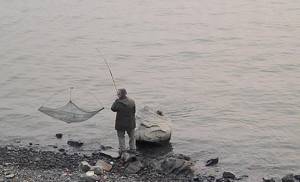
A wooden or aluminum pole for this small spider for catching live bait, as a rule, does not exceed four meters, and a seven-meter piece of rope or cord 6–8 mm thick is sufficient for most conditions for conducting the preparatory part of the main live bait fishing. Some models of the dwarf are equipped with side wing-aprons that rise 5–10 cm up along the perimeter of the mesh fabric. Their purpose is to serve to keep small fish in the mesh fabric, from rolling outside its boundaries at the moment when the tackle rises from the water.
For winter fishing
The design of the fishing gear for the peculiarities of winter fishing during the freeze-up period should allow the rods to fold freely when lowering and pulling the spider from the drilled hole. If the mesh fabric and rods of the winter version of the tackle are identical in appearance to the summer version, then the cross has a number of differences, which, first of all, lie in the spring mechanism that works to transform the product.
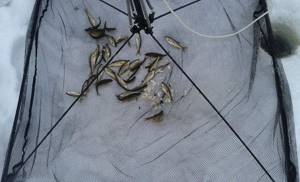
The stiffness of the spring is adjusted in such a way that it makes it possible to fold the rods and allow the angler to push the tackle through the hole, where, once in the water, it will open into working condition. When making a lift, resting the cross against the ice, the springs of the mechanism will work in the opposite direction and make it possible to lift into the hole a net folded into a bag with fish caught in it. To make it easier to feed the frame of this tackle, fishermen use ice drills of the largest diameters.
Large spiders
Fishing with spiders in excess of the size standards specified in the previous sections of the article in the vast majority of regions of our country is poaching. But large lifts are used in industrial fishing by fishing teams and even vessels specialized for such a device. Of course, due to their large mass, such spiders cannot be lifted by hand and electric winches with metal cables are used for this. For fishing, the poacher uses an elongated and durable pole, but made of lightweight materials, and a reliable synthetic rope.
Important! It is tempting to catch unsuspecting migrating or roosting fish in large quantities in large quantities, but do not forget that for violations of the law there are now quite significant fines, for which it is better to acquire legal and high-quality fishing equipment for legal sport and amateur fishing.
Spider fishing in summer. How to make a spider for fishing and what types exist
Many homemade devices, invented and created by fishermen around the world not only in the 20th and 21st centuries, but also much earlier, are still used today in Russia. At the same time, some of the handmade products are, for unknown reasons, poachers, that is, prohibited by law.
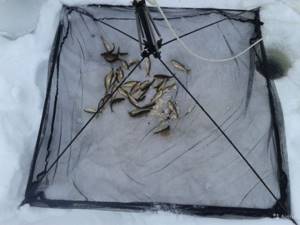
But they are still used in the country by thousands of underwater and ice fishing enthusiasts. At the same time, no one earned at least an extra thousand from fishing to buy a new net or modern fish bait. This can be said about fishing lift spiders.
How to make a fishing spider with your own hands
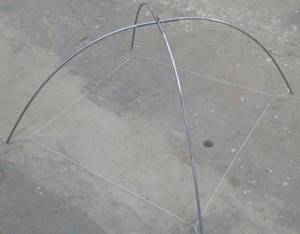
A fishing spider is a fairly elementary piece of equipment in its structure and composition of elements, and it can be made at home, with your own hands, without much difficulty. The basis of the equipment is the net; all other parts of the equipment can be adapted from available means, which makes it possible to assemble a spider even in the field. For the base of the lift, a network woven from synthetic threads, which are least susceptible to rotting, is suitable. You can use vine or willow twigs as arches, and equip the crosspiece with a strong joint knitting of four frame elements. Self-production of even such a primitive spider for fishing can allow you to catch a certain amount of fish in an extreme situation. But then we will discuss the possibility of manufacturing gear at home using the industrial method, giving not only the algorithm for assembling the gear itself, but also determining the list of materials and tools necessary for the production of the product.
Required materials and tools
Before starting the manufacture of the lift, you need to decide on the dimensions of the final product in order to correctly select the mesh fabric required in terms of area, and also purchase a sufficient amount of metal rod for the arcs of the device. As we have already mentioned, it is best to purchase a mesh made of nylon fishing line for lifts, which is a fairly durable synthetic material that does not require special care after using it in a damp environment. To stretch and attach the net to the arcs, you will need to purchase a polymer thread with a diameter of 2–3 mm, slightly larger than the length of the perimeter of the net. To make arcs, you need a rigid metal rod or reinforcement not exceeding 3 mm in diameter.

The fisherman will also need tubes for making a cross, the diameter of which should be comparable to the diameter of the metal rod that fits tightly into the hole of the pipe blank. Under the pole, wooden stakes or duralumin pipes up to six meters long and not exceeding 40 mm in thickness are used. To ensure the spider rises from the water, you will need about 10 meters of nylon cord no thicker than 8 mm.
Of the tools, the most complex equipment will be the welding machine, which will be needed to assemble the cross. In addition to welding equipment, you should have a small cutting machine or a hacksaw for metal, as well as pliers and a hammer for arranging hooks on metal rods for fastening the net. A sharp knife would be useful for working with nylon twine and tension threads.
Instructions for making a spider for fishing
Having decided on the size of the future lift, cut out the mesh fabric of the required perimeter and stretch a tension thread along its edges, which is tightly attached to the corners of the mesh, leaving loops. The next step is to prepare the crosspiece by welding its frame from tubes pre-cut to size. In the upper part of the cross, exactly in the center of the product, a fastening ring for winding the rope is mounted. Hooks are placed on four cut rods and loops made from thread drawn into the fabric are attached to them.
Next, the rods are tried on the crosspiece in such a way that when installing the rod into the hole of the tube on the canvas, a small sack is obtained, otherwise there is a sag of the mesh visible to the eye. The rods are cut to the required size and inserted into the crosspiece, completing the main assembly of the lift with your own hands with this operation. Now all that remains is to tie the fastening cord to the loop of the cross, connecting it to a pole selected for the fishing conditions, and you can go fishing.
How to make a fishing spider
The dimensions of this gear can be different, most often with an area of one square meter or more (sometimes up to nine). The small-sized spider is used to catch fry and then use them as live bait for larger prey. It is typical that the larger the size of the selected gear, the easier it will be to catch large fish. However, there is no need to increase the dimensions in vain more than is dictated by objective reasons, because then the ascent speed will drop, the advantage of a large spider will be lost, and the prey will simply swim out of the trap.
Another subtlety - the larger the spider used, the more physical strength will be required from the fisherman himself, because it is not easy to drag a large catch, lifting it quickly enough through the water column.
Best places to catch spiders
Spider fishing requires the angler to know places with clean bottoms that are free of snags, aquatic vegetation and construction debris that can get caught on the installed net. Reservoirs with a strong current, which can carry away a net with their flow, are not always convenient for fishing with a lift. Most suitable for fishing with this type of device are flat or slightly sloped bottoms next to underwater anomalies in the form of the same snags, massive stones, bushes of vegetation or reed walls.
Fishing is promising at the bottom of the pit, where the fish likes to hide during dangers, or after having fed during daylight hours, take refuge for the night. They always catch fish in water areas near bridges and directly under the structures themselves, where fish find secluded corners in parts of the reservoir shaded by the structure. Small fish, live bait, are caught on coastal shallows and sandy approaches to beaches, as well as in quiet creeks and backwaters, installing a lift near the boundaries of clear water and surface algae, mud collected in the quiet waters, or duckweed covering the reservoir.
Spider lifts
- VK
Based on the type of frame to which the net is attached, this type of gear can be divided into two large groups: spider lifts and rigid-rim lifts. The spider net is placed without any slack or with very minimal slack. However, at the moment of rapid lifting, the legs of the “spider”, curved from a thin and flexible steel rod, bend even more from the resistance of the water and the weight of the caught fish, and the net web sags.
ATTENTION! The materials in this section are intended for informational reading only!
To better capture fish swimming in the water column or on the surface, sometimes vertical walls from a net 10–20 cm high are attached around the perimeter of the “spider”. For catching bottom fish such as burbot, ruffe, gudgeon, such an improvement does not make any sense. .
The sizes of the “spiders” are very different. They range from 1 x 1 m (the so-called “small fish”) to 3 x 3 m. The larger the size of the tackle, the easier it is to capture large and strong fish, but it cannot be increased indefinitely - the decreasing lifting speed will negate all the advantages from the increased area, and catches will fall. In addition, a large “spider” requires much more physical effort to catch.
Classic spider lift with four legs
“Spiders” are lifted out of the water in different ways. Small and medium-sized ones are pulled out by moving the rope with their hands. This method is common when fishing from bridges, piers, etc. When fishing from the shore or boat, use a light, strong pole of greater or lesser length. The largest lifts are removed using special devices: either poles ending in a rotating block through which a rope is passed, or structures reminiscent of a well “crane” - a long boom hinged on a support dug into the bank, with a heavy counterweight at the short end . The net on the “spider” is usually installed with a medium-sized mesh, no more than 20–25 mm, except in cases where the gear is aimed at catching exclusively large fish, such as bream. But in most cases, “spiders” (at least in the Leningrad region) use the same tackle during the spring and autumn migration of different fish, including small ones (smelt, vendace, dace), so the net is most often used with small ones (10 –16 mm) mesh. Sometimes, so that the net is less noticeable at the bottom and creates less resistance when rising, it is made of monofilament (fishing line), but such “spiders” are less durable.
SELECTION OF LOCATION
The bottom should be flat, horizontal or slightly sloping. Usually they fish from year to year in the same favorite places, but nevertheless, before starting fishing, it doesn’t hurt to check the bottom with a hook or grapple anchor, and if you find foreign objects brought during ice drift or high water, remove them. You need to fish where fish going to spawn or moving down are delayed, concentrated: near any obstacles that sharply narrow the river bed, near old and existing (if permitted by the rules) hydraulic structures, in creeks with a slow circular flow adjacent to rapids, – the fish usually rests there, gaining strength before the assault of the fast current.
Since the construction of permanent barriers (pins, ties) is almost universally prohibited, it makes sense to install temporary barriers (tie a fencing wing or a fine-mesh gill net on stakes), but it should be borne in mind that where the installation of such barriers is permitted, they should cover no more than 2 /3 of the width of the river, leaving its deepest part (the fairway) free.
Most often, fishing is carried out blindly, with regular (more or less frequent) lifting of the gear, since even at shallow depths it is difficult to see prey caught in the “spider” in the muddy spring water. When small fish travel in dense schools, this fishing method is fully justified. But for large fish that rarely enter the “spider”, a rather ingenious method has been invented, the so-called “fishing with iron”.
A large square sheet of tin is taken, larger than the lift (or several smaller sheets are joined together), painted white with waterproof paint and pressed tightly to the bottom with heavy stones placed in the corners. The “spider” naturally lowers itself so that its web rests on the painted sheet metal. At a depth of up to 1 m (sometimes more, depending on the turbidity of the water), the fisherman can distinguish the silhouette of a large fish on a white background and sharply lifts the tackle when the prey is as close as possible to. In this way, it is possible to catch even such cautious fish as large trout and salmon, which are very rarely caught when fishing blindly. And fishing itself becomes much more interesting and exciting.
By the way, fishing is based on the same principle with small “spiders” - larvae, from which, instead of a regular net, a canvas made of white window tulle is suspended: the fisherman sees how the fish (mostly minnows) enter the white cloth - and sharply lifts the larvae. In addition, fishing is carried out directly at the spawning sites - here “spiders” are used in smaller sizes (up to 1.5 x 1.5 m, in rare cases up to 2 x 2 m) and are lifted with a simple pole, without blocks and “cranes” . Naturally, you can only catch those species of fish that prefer to spawn in shallow water: crucian carp, carp, pike, etc.
Usually, a catcher in a rubber suit carefully enters the thickets of underwater or flooded vegetation where the fish “rubs”, quietly lowers the “spider” into the water and quickly picks it up as soon as he sees that the fish has begun to play and splash above him. The water at the spawning grounds is already quite clear, so the longer the pole (that is, the farther the “spider” is from the angler), the greater the chances of success. Although even pikes of considerable size can come right up to the fisherman’s feet if he stands motionless, without moving. In the summer, after the end of spawning, “spiders” are used much less frequently, as a rule, mainly in places where fish accumulate naturally: near dam spillways, etc.
RIGID FRAME LIFT
The frame for such a lift is made either round or square. The net is placed with more sag than on a “spider”, since during lifting the lift frame remains motionless and the sag does not increase. A lift with a rigid frame
Round Frame Lift with Weight Ring
The methods of use are similar to fishing with “spiders”, but there is a significant difference: a lift with a rigid frame can be used in a stronger current than a “spider” - so that it does not lie horizontally on the bottom, but is at an angle, touching the bottom with one its edge. In semi-flowing ponds, where verkhovka is found in abundance, it is caught in huge quantities in winter, from under the ice, with small round lifts (60–70 cm in diameter) with a fine mesh, cutting lanes of the appropriate diameter.
LIFT FOR WALKING FISHING
This gear and this method of fishing appeared as a result of the reluctance to violate fishing rules and at the same time achieve good results when fishing with a lift of more than modest sizes. The fact is that the fishing rules in force for many years in the Leningrad region allowed fishing with a lift with a mesh of 10 mm and a mesh size of no more than 1x1 m. The catch rate was set not in kilograms, but in pieces - no more than 50 per catcher and gear .
The construction is quite simple to make: a round steel bar 3.2–3.4 m long and 6–8 mm in diameter is carefully sanded and coated with 2–3 layers of waterproof dark paint. Then a square with a side of 80–85 cm is bent from the rod. A square piece of netting 1 x 1 m with a mesh of 10 mm is put on it and evenly straightened. The ends of the rod are connected (inserted into a piece of aluminum tube 5–6 cm long and with the corresponding internal diameter).
Lift for running fishing: 1 – pole; 2 – slings; 3 – frame made of steel rod; 4 – network
You can make the frame collapsible, from four rods connected by corners from the same tube. For reliability, the edges of the mesh are sewn to the rim with a twisted nylon cord with a diameter of 1.5 mm. Slings are attached to the corners of the rim, each about 1 m long. Since the slings must have some rigidity, it is better to make them not from a cord, but from insulated copper wire with a diameter of 4–5 mm (slings made from aluminum wire are too brittle, and those from steel are too brittle). springy). At the top, the slings are connected together and securely fastened with a short (10–15 cm) rope to a four-meter pole, preferably well-dried and light. The gear is ready, but catching a good fish with it is not so easy; the usual methods of fishing with a lift will not bring success.
CHOICE OF PLACE AND TIME
Fishing is carried out on small rivers and streams, but they must be chosen carefully: small tributaries of large rivers not far from the confluence, streams flowing into lakes rich in fish are suitable. Small rivers that are dammed for agricultural purposes (for example, for irrigation) are very good, forming small reservoirs: the water level in such reservoirs constantly fluctuates, the banks are often bare clay slopes, on which, due to the constant change in water level, nothing has time to take root. aquatic and terrestrial vegetation. As a result, the fish, accustomed to spawning on coastal vegetation, do not find a place to spawn; in large numbers they go upstream in search of convenient spawning grounds and end up in a narrow and shallow river. Also of interest are the narrow and shallow upper reaches of rivers, where there are pools rich in fish a few kilometers downstream.
The time for fishing must be chosen no less carefully than the place, otherwise you will only catch fish that permanently live in the river, usually small ones. The ides are the first to rise to the very upper reaches (their passage occurs only in the upper reaches or on small tributaries of large and medium-sized rivers), escaping from the muddy water. It is difficult to name the calendar dates for this move; they not only vary depending on the specific location, but also on the same body of water they can shift by 2–3 weeks in one direction or another, depending on whether spring is early or late. But the ide always rises very early, when ice drift continues on the large river. The pike begins its ascent to the spawning grounds later, sometimes its movement against the current coincides with the rolling of the ide, but more often a certain period of time passes between them. It must be taken into account that pike are not inclined to long spawning journeys, and the more suitable places for spawning there are downstream of the river, the fewer pikes rise to the upper reaches. The inverse relationship is also true. For example, if the winter was snowless and in the spring the water in the lake did not rise and flood the coastal lowlands, then in the streams flowing into the lake you can count on an excellent pike catch.
The roach begins its move somewhat later than the pike, but in catches (when fishing with a running lift) it is adjacent to it much more often than the pike with the ide. The roach rises very high, sometimes into such narrow upper reaches that it cannot find suitable quiet pools for spawning, and unspawned roach can be caught there at the end of May, even in June, and the eggs in the latter case begin to dissolve.
The perch begins its move even later than the roach. It is never massive or regular - usually individual flocks of 3-4 spawned humpback whales and one and a half dozen medium-sized milkfish rise upstream. This is explained by the fact that perch spawns at greater depths and does not strive to find heated shallow pools, like pike or roach; its spring move against the current is not associated with the search for spawning grounds, but with the desire to leave the muddy water for clean water. Dace pour into streams and upper reaches very amicably, in dense schools.
FISHING TACTICS
You have to fish not from the shore, but by wading, and a rubber suit is an indispensable accessory for fishing. To begin with, the catcher enters the water, choosing a shallow riffle with a sandy or clay bottom, and without unnecessary noise begins to stir up the water with his feet. Sometimes this technique is not required, but in general the water in the upper reaches brightens quite quickly, becoming too transparent for successful fishing. When fishing at night (more effective than daytime, but not applicable everywhere), there is no need to stir up the water. Having achieved that the water 10–15 m downstream has become completely opaque, they begin fishing. It consists of almost simultaneously performing two techniques.
Firstly, the lift is cast almost close to the shore downstream from where the catcher stands, and so that the tackle does not lie horizontally, but stands at an angle: one side of the square frame touches the bottom, the other is as close as possible to the surface of the water , or even protrudes slightly above it. The lines are in a tense position, and the fisherman constantly monitors and controls the position of the gear. The walking lift works most effectively when its frame is at an angle of 45°, that is, at a depth of 50–60 cm.
Secondly, simultaneously with casting the tackle, the fisherman begins to catch fish into it. Both hands are busy, so it’s impossible to use something like the well-known “botalok”, you have to scare the fish standing under the shore with your feet: noisily splash your boots, turn over pitfalls, etc. Synchronization of these two techniques is the main key to success. The mechanics here are as follows: when casting vigorously, the lift descends into the water quite noisily and scares away the fish standing nearby. The one that rushed downstream is not of interest to us for now - perhaps it will be caught during subsequent fishing cycles. But the one that rushed towards the fisherman should be directed straight into the lift.
Scaring and driving the fish into the lift, the fisherman simultaneously takes several steps forward, and when half the distance to the lift has been covered, he lifts the tackle with a sharp movement of the pole. Impacts of pikes and ides (weighing 400 g and above) on the net are clearly felt by the fisherman, and in this case the tackle must be lifted immediately. If a fairly large fish splashes up on the surface near the lift (most often a pike rises to the top), you also need to immediately pull the pole up, in most cases the catch will end up in the net.
Having taken the fish out of the net, you must immediately continue fishing further downstream until the frightened and darted fish comes to its senses and begins to rise, passing by the fisherman standing near the shore. The most difficult thing to catch using this method is ide - a very sensitive and cautious fish, fast-swimming and also prone to aerial acrobatics. It is extremely disappointing when a large ide performs a somersault in the air, jumps out of a lift that is almost taken out of the water, plops down into the river and leaves. Sometimes, especially if the water is almost level with the banks, after a jump the fish falls not into the river, but onto the shore, here the fisherman must not yawn, but quickly cover the ide with the tackle taken out of the water, otherwise the second jump will return the fish to its native element.
If after the first experiments it became clear that ide predominates in a river or stream, then the fishing tactics are slightly changed: the lift is thrown as far as possible, the entire length of the pole, and raised faster than usual, scaring the fish with just one or two splashes of boots, for a cautious ide quite enough. Another way of catching sensitive fish is also possible: the lift is not cast noisily near the shore, but is quietly lowered closer to the middle of the river, to the rapids; then you need to allow the current to carry it down, holding it with a pole, quietly and carefully bring it closer to the shore, and only then begin the surge. When fishing for pike and roach, such tricks are unnecessary. But the roach is more careful than the toothy predator, and to catch it, you need to lift the tackle a little earlier, otherwise the roaches that hit the net will have time to jump out of it. The pike is not so timid and sometimes stubbornly does not want to go into the lift, rushing about underfoot (the blows of its hard snout are clearly felt through the rubber fabric of the suit), sometimes jumping out to the surface. And if the fishing is aimed specifically at pike, then the surge can be longer and noisier, and the tackle is lifted when there are two or three steps left before it.
Sometimes it happens that after walking a hundred meters along a river, a fisherman is not at all happy with his catch: small roaches and squints, gudgeons and loaches - in general, local, resident fish that constantly stay in the upper reaches. In this case, it makes sense to continue fishing, but to go faster, not so carefully fishing the places you like - it often happens that the fish’s run has just begun, and it has not had time to reach this place. The tactics for catching burbot are strikingly different from the methods used for ide - the lift is lowered into the water as close to the fisherman as possible (the burbot does not react at all to its splash), and the surge is carried out very long and carefully: every pitfall is turned over, the fish are driven out from under shores washed away by water, from under the roots of coastal bushes and trees, etc. The impact of a burbot, even a large one, on a lift is almost never felt; it is obvious that it does not swim too fast and is in no hurry to leave the net of the lift (perhaps mistaking it for suitable temporary underwater shelter). It is convenient to carry out walking fishing with a lift together: one catcher goes along the right bank, the other along the left, and at the same time both should, if possible, synchronize casts and surges.
When fishing alone, you have to go in a zigzag, from one bank to another, trying, if not to catch, then at least to drive down all the fish standing under the banks. Any whirlpools with a depth of more than a meter encountered along the way should be passed without fishing, only scaring the fish - during the time the tackle is lifted from such a depth, the fish manages to escape from the small area of the net. The pools, whose depth exceeds the height of a rubber suit, go around the shore. Naturally, it is better to fish in well-known reservoirs, and to exercise maximum caution in new ones, even if it is to the detriment of the catch.
A rubber suit for fishing must be chosen very carefully. Boots and rubber pants glued to them during the surge constantly come into contact with stones, snags and other underwater objects, and it is very easy to damage a low-quality (too thin) suit. The lower part of a chemical protection suit is not suitable for such fishing, rarely withstanding more than one or two fishing trips. In any case, when fishing, it’s a good idea to have a bicycle first aid kit with you so that you can quickly patch up a hole - icy spring water flowing into the suit can completely ruin your fishing.
A. Shaganov
Related articles:
Fishing with mugs
Fishing with a fly rod
Eel fishing
Catching perch with artificial and natural worms
Features of fishing with a spider
Having decided on a suitable place on the pond, spider fishing begins with installing the gear. They try to silently lower the fishing device to the surface of the water at a promising point and let it sink deeper, settling on the bottom. The pole rope, attached to the handle, remains in the hands of the fisherman. After installing the spider, they wait for a certain period of time, which is initially set arbitrarily, finding out the density of fish in the fished area of the reservoir. After waiting time, they smoothly lift the net and, if there are fish, pull the device ashore, collecting the catch.
Important! If there are no results after a couple of lifts of the fishing gear, you need to increase the time you wait for the trophies to arrive.
Also, success can be brought by feeding the net installation area, when after casting, a portion of bait is fed into the lift, thus attracting live bait to the fishing site. Another effective method of fishing is to install a metal plate in the net that is different in color from the bottom, which attracts fish and also serves as a weight that allows you to install the net faster and improves its stability when fishing in currents.

